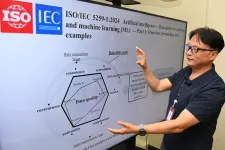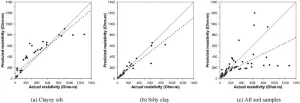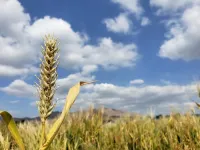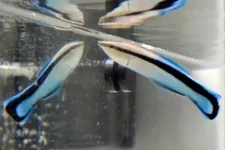(Press-News.org) The Wyss Institute at Harvard University announced today that Ropirio Therapeutics, Inc. (Ropirio) has secured a worldwide, exclusive license from Harvard’s Office of Technology Development (OTD) and Boston University (BU)’s Technology Development office for novel molecules that activate the lymphatic system - a first in the pharma industry.
“There has been a tremendous amount of research into the lymphatic system over the last decade, with scientists uncovering new lymphatic vasculature and understanding the critical role it plays across a wide range of serious diseases. Ropirio is building on this explosion of research and will be the first company to develop therapeutics that specifically target and activate the lymphatic system, enabling the treatment of a multitude of serious diseases.” said Jerald Korn, CEO of Ropirio.
Ropirio’s assets include a pioneering in vitro platform that models human lymphatic vessels, as well as a stable of proprietary small molecules that modulate specific targets within lymphatic cells.
The human body’s lymphatic system is extensive and complex. It comprises a network of vessels that collect and transport fluids throughout the body. This system is also a major conduit for immune cells, and thus critical for healthy immune responses.
Work conducted in the lab of Wyss Core Faculty member Chris Chen, M.D., Ph.D. led to the creation of a lymphatic vessel -on-a-chip that accurately models human lymphatics in a microfluidic in vitro system. The 3D model consists of two tiny channels suspended in a collagen matrix: one lined with human lymphatic cells to form a vessel, the other perfused with a surrogate lymph fluid composed of molecules including fatty acids, phospholipids, albumin, and insoluble particles. By pressurizing the fluid channel, the researchers were able to replicate the process by which fluid from around the body’s tissues drains into lymph vessels.
Chen’s team discovered that the addition of inflammatory cytokines to their lymphatic vessel chip significantly reduced lymphatic drainage, mimicking human response to inflammation. Building on this finding, the team identified a druggable pathway that can activate lymphatics by opening junctions between lymphatic endothelial cells and restoring normal drainage, even in the setting of inflammation. This biology is specific to lymphatic tissues, allowing for selective activation of drainage without causing side effects in other parts of the body.
“Our work in the lab revealed just how critical it is to understand the molecular underpinnings of human biology in order to create effective treatments for diseases. Prior to this research, it was thought that lymphatic vessels drained fluid passively, but we demonstrated that lymphatics respond actively to external factors, opening cell-cell junctions in response to fluid and closing these junctions in the face of inflammation. We were also able to demonstrate that by inhibiting a target, we could restore lymphatic drainage even in the presence of inflammation,” said Chen, who is also the William Fairfield Warren Distinguished Professor of Biomedical Engineering and Director of the Biological Design Center at BU.
Following this breakthrough discovery, a team at the Wyss Institute comprising industry veterans Ken Carlson, Ph.D., Joel Moore, Ph.D., and Sylvie Bernier, Ph.D coalesced in order to translate this biological result into a tangible human therapeutic. The group rapidly assembled a complete drug discovery platform that ultimately produced potent, orally bioavailable compounds that demonstrated efficacy in the gold-standard animal model for secondary lymphedema. “This program exemplified the collaborative power of the Wyss Institute’s translational engine through its transformation of fundamental biological science into the foundation of Ropirio Therapeutics,” said Moore, who now serves as the SVP of Non-Clinical Development at Ropirio.
Ropirio was founded by Chen along with fellow Wyss Faculty member Sangeeta Bhatia, M.D., Ph.D., who is also the John J. and Dorothy Wilson Professor at MIT’s Institute for Medical Engineering and Science and Electrical Engineering and Computer Science; Rene Russo, Pharm.D., Chief Executive Officer of Xilio Therapeutics; and Joel Moore, Ph.D., SVP of Non-Clinical Development at Ropirio and Medicinal Chemist at the Wyss Institute. Ropirio’s portfolio includes several small molecule drugs targeting the lymphatic system, which it aims to start testing in clinical trials in 2026.
“It has been exhilarating to see how quickly the Ropirio team progressed from an idea in the lab to a set of potentially revolutionary treatments for the lymphatic system by combining forefront science with an experienced team of drug developers at the Institute,” said Wyss Founding Director and Core Faculty member Don Ingber, M.D., Ph.D. “They are a model example of the Wyss Institute’s commitment to accelerating impactful technologies to the market, and we are lucky to count them among our outstanding community of Lumineers.” Ingber is also the Judah Folkman Professor of Vascular Biology at HMS and Boston Children’s Hospital and the Hansjörg Wyss Professor of Biologically Inspired Engineering at Harvard’s John A. Paulson School of Engineering and Applied Sciences.
END
Ropirio launches from Wyss Institute to develop first-in-class lymphatic medicines
The company is leveraging a discovery program developed at Harvard and Boston University to treat a wide range of serious diseases
2024-09-11
ELSE PRESS RELEASES FROM THIS DATE:
Oxycodone use in Australia dropped 45% after policy changes to opioid prescribing
2024-09-11
Between 2018 and 2020, Australia implemented policy changes to improve the quality and safety of opioid prescribing, with a specific focus on oxycodone. A new study led by The University of Queensland (UQ) using wastewater analysis has determined that oxycodone consumption in Australia dropped by 45% from 2019 to 2020, coinciding with those national policy changes.
In November 2019, the Australian National Prescribing Service launched a federal initiative to improve opioid prescribing. The initiative involved alerting high-prescribing clinicians that their opioid prescribing practices were outside typical ...
Hot streets, historic bias: effects on neighborhood walking in older adults
2024-09-11
A neighborhood’s walkability is affected by many factors such as street connectivity and density; access to destinations and aesthetics; investment in walking and biking infrastructure; and the presence or absence of urban natural features, specifically tree cover.
Not all neighborhoods are alike. Many neighborhoods in impoverished and minority communities lack the cooling effect of vegetation and tree cover, especially in urbanized areas. As a result, residents face the “heat island effect,” where temperatures remain higher in urban areas ...
ETRI establishes international standards for AI safety and reliability support
2024-09-11
Recently, many major countries around the world, starting with the U.S., Japan, Germany, China, U.K., etc., have issued an administrative order to ensure the safety of AI technology, putting an emphasis on the safe, effective implementation of AI into their systems. In line with such trends, Korean researchers have collaborated with renowned AI experts from all around the world to create new AI-related international standards, garnering attention from the global AI community.
Proposal No.
Title
Status
ISO/IEC ...
Atypical metabolite levels at birth may increase SIDS risk
2024-09-11
WHAT:
Newborns who had an atypical pattern of metabolites were more than 14 times as likely to die of sudden infant death syndrome (SIDS), compared to infants who had more typical metabolic patterns, according to a study funded in part by the National Institutes of Health. Metabolites are molecules produced by the body’s various chemical reactions. Researchers found that infants who died of SIDS had a specific pattern of metabolites compared to infants who lived to their first year. The researchers believe that checking for this pattern could provide ...
How toxic are they? Researchers investigate the environmental consequences of new biotechnological pesticides
2024-09-11
Biotechnological pesticides are a promising alternative to traditional chemical pesticides. But we have limited knowledge of how toxic they are to other organisms in the environment beyond regulatory assessments. A new research centre will now work to provide this knowledge – especially to ensure the EU has a chance of joining the growing market for biotechnological pesticides. As for now, Europe has failed to keep up.
"If a thing kills something, we need to know how it kills, and who and what else it may kill," says Professor Nina Cedergreen of the University of Copenhagen’s Department of Plant and Environmental Sciences.
She is ...
Advancing power grounding systems: A novel predictive model for soil resistivity
2024-09-11
Proper power grounding systems are necessary for maintaining the safety and reliability of critical electrical subsystem infrastructure, such as substations. Power grounding systems provide a low-resistance path for electrical fault currents to flow into the earth, preventing electrical shocks, fires, and damage to vital equipment. Investigation of soil resistivity is crucial for designing power grounding systems. For the most cost-effective and efficient grounding systems for electrical substations, it is imperative to carefully ...
Unique nanodisk pushing photonic research forward
2024-09-11
Researchers at Chalmers University of Technology, in Sweden, have for the first time succeeded in combining two major research fields in photonics by creating a nanoobject with unique optical qualities. Since the object is a thousand times thinner than the human hair, yet very powerful, the breakthrough has great potential in the development of efficient and compact nonlinear optical devices. “My feeling is that this discovery has a great potential,” says Professor Timur Shegai, who led the study at Chalmers.
Photonic applications harness the power of light-matter interactions to generate ...
Century-old experiment secures beer and whiskey’s future
2024-09-11
Thanks to an experiment started before the Great Depression, researchers have pinpointed the genes behind the remarkable adaptability of barley, a key ingredient in beer and whiskey. These insights could ensure the crop’s continued survival amidst rapid climate change.
Grown everywhere from Asia and Egypt to Norway and the Andes mountains of South America, barley is one of the world’s most important cereal crops and has been for at least 12,000 years. As it has spread across the globe, random ...
Researchers improve search for cancer drivers
2024-09-11
PULLMAN, Wash. -- A computer algorithm can efficiently find genetic mutations that work together to drive cancer as well as other important genetic clues that researchers might someday use to develop new treatments for a variety of cancers.
Reporting in the journal Frontiers in Bioinformatics, a Washington State University-led team used a novel network computer model to find co-occurring mutations as well as other similarities among DNA sequence elements across several types of cancer. The model allows for easier searches for patterns in huge seas of cancer genetic data.
“This is a ...
Mirror, mirror, in my tank, who’s the biggest fish of all?
2024-09-11
What if that proverbial man in the mirror was a fish? Would it change its ways? According to an Osaka Metropolitan University-led research group, yes, it would.
In what the researchers say in Scientific Reports is the first time for a non-human animal to be demonstrated to possess some mental states (e.g., mental body image, standards, intentions, goals), which are elements of private self-awareness, bluestreak cleaner wrasse (Labroides dimidiatus) checked their body size in a mirror before choosing whether to attack fish that were slightly larger or smaller than themselves.
The ...
LAST 30 PRESS RELEASES:
Numbers in our sights affect how we perceive space
SIMJ announces global collaborative book project in commemoration of its 75th anniversary
Air pollution exposure and birth weight
Obstructive sleep apnea risk and mental health conditions among older adults
How talking slows eye movements behind the wheel
The Ceramic Society of Japan’s Oxoate Ceramics Research Association launches new international book project
Heart-brain connection: international study reveals the role of the vagus nerve in keeping the heart young
Researchers identify Rb1 as a predictive biomarker for a new therapeutic strategy in some breast cancers
Survey reveals ethical gaps slowing AI adoption in pediatric surgery
Stimulant ADHD medications work differently than thought
AI overestimates how smart people are, according to HSE economists
HSE researchers create genome-wide map of quadruplexes
Scientists boost cell "powerhouses" to burn more calories
Automatic label checking: The missing step in making reliable medical AI
Low daily alcohol intake linked to 50% heightened mouth cancer risk in India
American Meteorological Society announces Rick Spinrad as 2026 President-Elect
Biomass-based carbon capture spotlighted in newly released global climate webinar recording
Illuminating invisible nano pollutants: advanced bioimaging tracks the full journey of emerging nanoscale contaminants in living systems
How does age affect recovery from spinal cord injury?
Novel AI tool offers prognosis for patients with head and neck cancer
Fathers’ microplastic exposure tied to their children’s metabolic problems
Research validates laboratory model for studying high-grade serous ovarian cancer
SIR 2026 delivers transformative breakthroughs in minimally invasive medicine to improve patient care
Stem Cell Reports most downloaded papers of 2025 highlight the breadth and impact of stem cell research
Oxford-led study estimates NHS spends around 3% of its primary and secondary care budget on the health impacts of heat and cold in England
A researcher’s long quest leads to a smart composite breakthrough
Urban wild bees act as “microbial sensors” of city health.
New study finds where you live affects recovery after a hip fracture
Forecasting the impact of fully automated vehicle adoption on US road traffic injuries
Alcohol-related hospitalizations from 2016 to 2022
[Press-News.org] Ropirio launches from Wyss Institute to develop first-in-class lymphatic medicinesThe company is leveraging a discovery program developed at Harvard and Boston University to treat a wide range of serious diseases





